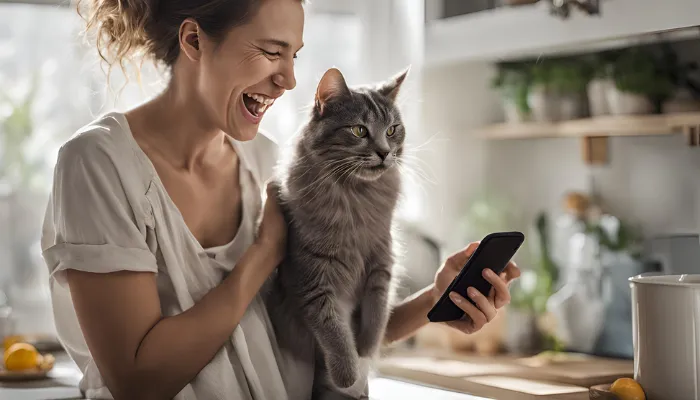How Do Cats Say “No”? Cats do not speak language like humans, and for that, they have their own way of saying ‘no.’ Refusal ‘saying’ doesn’t involve silence. Cats have a unique form of stealthy communication, and they use their bodies and voices in specific ways to show that they are not pleased with something.
Sharp hissing or tail flicking is a subtle way through which cats set their limits. Learning these signs is very important if you want to keep a good relationship with your cat and build trust. Using a cat translator can also help interpret these signals more effectively, making it easier to understand what your feline friend is trying to communicate. So, let us look at the many ways cats say, “no,” and how they expect you to handle that phrase.

How Cats Say “No” Through Body Language?
How Do Cats Say “No”? Felines are experts in observing their environment, and interpreting their body language is usually the best indicator of their feelings. Here are some common actions that cats perform with their bodies to express the term “no”:
- Tail Flicking or Lashing: Every cat’s tail has a special function and is almost like a mood barometer. The cat is annoyed or angry when they flick or lash their tails rapidly back and forth. It means, “I’m not happy about what’s happening.”
- Ears Flattened Back: Cats who place their ears pinned back are showing discomfort and fear. This indicates a defensive position that says, “I want this to stop and I don’t like it.”
- Turning Away or Walking Off: Cats are very self-reliant and in the case that something does not amuse them, there is no concern for walking away. Their back towards a door signals them saying, “I am good, thanks.”
- Arched Back and Puffed Fur: Fears tell a cat to appear bigger and puffing its fur helps in intimidation. This is a straightforward signal that often goes with the aggressiveness.
You can enhance your relationship with your feline buddy by recognizing their boundaries. This can be achieved by understanding how cats physically communicate ‘no.’
Vocalizations: The Sounds of Refusal
According to the behavioral observation of a cat’s life, even though cats are not as talkative as dogs, they have certain sounds that indicate refusal. Some of them include:
- Cats say ‘No’ in different ways, and one of them is by hissing. It is an aggressive emission that indicates the person has to heed to backed off because it could get worse.
- Growling sound is made by a cat when they are furious about something. It is low and grumpy, which means the cat is really displeased about something. This is an emotion that displays dissatisfaction with the current environment.
- Although most people connect the word’s meows with requests or greetings, sharp short meows are a clear indication of annoyance or refusal. It is the cat’s eloquent way of expressing, “Enough already!”
These sounds are a way of a cat setting its borders. How Do Cats Say “No”? Listening and understanding these sounds enhances a friendly relationship with a cat, which one must pay attention to when caring and expecting trust.
How to Respect Your Cat’s “No”?
Understanding how cats express the word “no” is only half the battle. Equally important is to know how their boundaries ought to be respected and dealt with. Below are some tips for respecting your cat’s refusal:
- Pay Attention to Body Language: Try to understand your cat’s discomfort cues as signals for you to stop.
- Give Them Space: If your cat chooses to walk away or hide, don’t force them to interact. They will come to you when they feel comfortable.
- Avoid Punishment: You should never punish your cat for its refusal. This would cause your cat to fear you and your presence.
- Provide Alternatives: If your cat seems to be uninterested in interacting with you in a particular way, try to use an alternative which they would enjoy.
Letting your cat set preferences for interaction plays a critical part in the wellbeing of the cat. It indirectly implies that the cat is being cared for and it is a safe environment.
Common Scenarios Where Cats Say “No”
To better understand How Do Cats Say “No”?, let’s look at some common scenarios and how cats might respond:
| Scenario | How Cats Say “No” |
|---|---|
| Being Picked Up | Struggling, hissing, or biting |
| Petting in a Sensitive Area | Tail flicking, flattening ears, or walking away |
| Introducing a New Pet | Hissing, growling, or hiding |
| Overstimulation During Play | Biting, scratching, or sudden disengagement |
By recognizing these responses, you’ll be better equipped to respect your cat’s boundaries and foster a more harmonious relationship.
Conclusion
How Do Cats Say “No”? Cats have different means to say “no” to their humans. Some cats will hiss while others will flick their tails or just walk away. Knwoing these signals is very important.
These muscle actions by cats will allow for an easier interaction with them. Cats are most comfortable when they know they can trust their owners with no judgments and understand their feelings.
